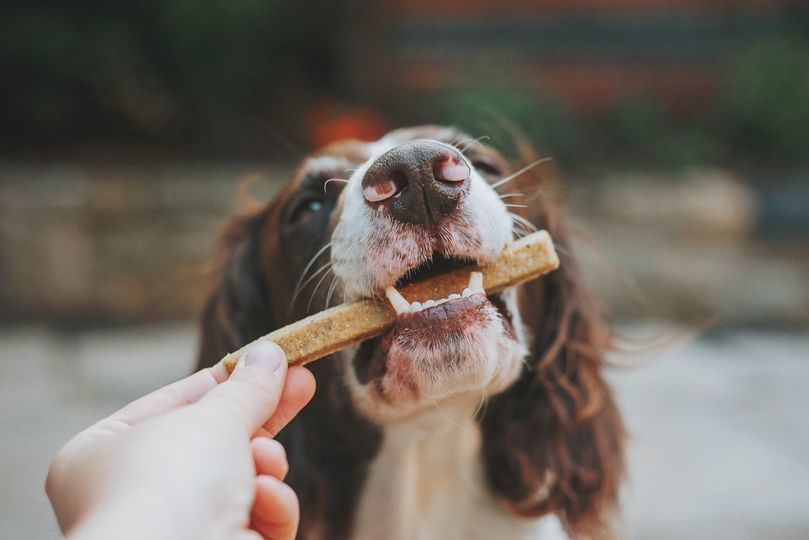PET FOOD TREATS - FRIEND OR FOE
TREATS – Slowly killing our pets?
I did a survey in April 2011 – and repeated a survey on dried pet food last week 20/5/21 – there has been absolutely NO change in food safety legislation!
Many treats are called ‘Jerky’. This is dehydrated meat & cooked by smoking. Can be hard on dogs due to salt content and often fatty meats are used, risking Pancreatitis. Watch out for any smoked or brined treats like pigs ears, recent research links smoked meat or coverings to mild cancer-causing agents. I have never seen a warning on these types of treats.
Irradiation – many overseas manufactured pet treats & foods are irradiated.
Only one Treat manufacturer admitted their product was irradiated but many imports esp. from the east and china, have to undergo Irradiation. This exposes the product to a radiation source (typically Cobalt 60 Isotope); this penetrates the entire product, deactivates microorganisms and significantly changes the molecular structure of the product including growth factors and cytokines. Cytokines are signaling proteins that assist in controlling the activity of other immune system cells, blood cells and the inflammatory response so one can see that there definitely should be a warning that the product has been irradiated but MPI do not require it under current regulations. NB: Much human food is also irradiated!
Nick Cave Massey Veterinarian/Nutritionist mentioned dogs were becoming sick after eating imported jerky from Asia and China – Fanconi Syndrome affects kidney tubules. This Syndrome can be triggered by exposure to heavy metals and especially outdated drugs like tetracycline and gentamicin in the Treats.
This also raises the question of Country of Origin. If a pet food imports one of its ingredients from Asia but manufactures it in NZ it can say it’s a NZ product.
Richard Brake of NZ Pet Foods Manufacturers Assoc admits there should be better data gathering regulations. Current regulations are too broad and useless when discussing pet food. For example, Sulphites added (unlabeled) to make food look and smell fresh. degrade B1 (thiamine) so instead of making it compulsory to label sulphites, it is sufficient just to add more Thiamine to counteract the effects to meet AAFCO standards. How insane is that!
It is generally accepted amongst the more cynical (including myself) that if you take a bucket of sand, add vitamins and minerals to it, it will meet the ‘complete and balanced’ standards of AAFCO. (The Association of American Feed Control Officials.) If you see this statement on your pet food, it certainly does NOT mean peace of mind for your feeding program; on the contrary, I would be enormously suspicious.
Crude Protein…
This is usually displayed on the packet but it means tiddly-squeak for the health of your pet.
Crude protein/fat = this indicates the total content BUT is not necessarily the amount of protein /fat that is digestible.
Additives:
Colourings –many are suspected carcinogens yet still appearing in many cat and dog treats on the shelf today.
A Nestles Purina cat treat had these ones –
FD&C Red No.40 to keep the meat a healthy pink ‘fresh’ colour so you will think it’s ‘fresh’. aka Sodium Nitrate: used as a food colouring (RED) and as a preservative. The preservative produces carcinogenic substances called nitrosamines. Yellow No.5 and Blue No. 2 are both health suspects and Blue is thought to increase viral susceptibility.
BHA & BHT:
both are preservatives; have been associated with liver damage, foetal abnormalities and metabolic stress. They also have a questionable link to cancer.
Another well-advertised brand made by Mars demonstrates how little information is legally required on the packet.
– Humectant,( these bind moisture, prevents foods from drying out and stops the sugar from crystallising ) Some reactions to humectants – diarrhea, hyperactivity, irritability, rhinitis, itching).
– Salt (. Salt preserves meat but it seriously upsets the calcium potassium balance in the pet’s body and leads to chronic ill-health.
– Preservatives (don’t have to tell you )
– Colour, flavor, antioxidant – no mention of which one.
Titanium dioxide – although approved by the FDA it has strict guidelines as to quantities used in food (usually used for industrial adhesives, plastic rubber) Its used in food is to enhance and brighten white foods (dairy, frostings).
Inulin – a starchy substance found in variety of veges & fruits but Chicory is the usual choice. Increases sweetness in food, alters texture, replaces fats, but decreases the body’s ability to make certain kinds of fats. Can legally call it a ‘prebiotic’. Side effects occur mainly in the stomach with gas, bloating, diarrhea, cramps. This is a classic example of isolating a substance and expecting it to be as safe as it would be in a naturally combined state.
Tapioca – adds bulk, creates uniform texture & shape. Gives more poop..
Calcium Propionate: a mould/fungus inhibitor commonly added to many foods. A study in the “Journal of Paediatric Child Health” in 2002 reported that although calcium propionate may have little to no side effects on the average person, chronic exposure, especially in children, might induce a myriad of behavioral changes. This is noticed in some dogs and cats that I treat!
Ethoxyquin: didn’t find any labels with this nasty on it but could well be under another name.one of the most highly debated items in dog foods. A chemical preservative widely used to prevent spoilage. Alleged that ethoxyquin has caused cancer, liver/kidney damage and thyroid dysfunction; reproductive failure and more.
Potassium Sorbate: used to inhibit moulds, yeasts and fungi in many foods. Considered non-toxic but no one knows what the cumulative effects are. (E.number 202)
Propylene Glycol: a chemical preservative designed for use in anti freeze, oils and waxes. Causes irregularities in the red blood cells of cats. Dogs and cats become addicted to it (hence its danger around car repair yards and home garages). Also causes skin problems, hair loss, dull coat, diarrhoea, over weight and even death in both dogs and cats. Used in Nestle Purina Beneful & some Chow brands.
Tocopherols (Vitamin C & E): naturally occurring compounds used as natural preservatives. They function as anti oxidants, preventing the oxidation of fatty acids, vitamins and some other nutrients. Tocopherols are being used more frequently but have a short shelf life, especially once the bag has been opened. This means they need other additives to ‘preserve’ the preservatives!
WHAT YOU CAN USE INSTEAD OF DANGEROUS TREATS
Fruit, carrot, a SMALL piece of what ever food they normally get; play toy, voice control (praise), pats.

